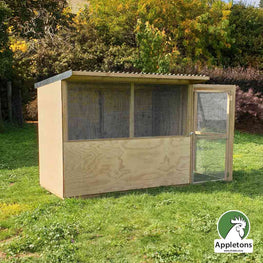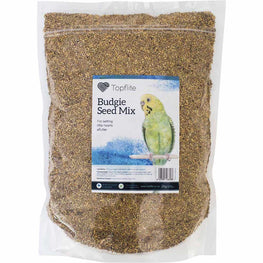Budgie Cages & Cleaning Tips
Your budgie cage should be set up before you bring the bird home. Don’t make do with a temporary cage while you find the time and money to set up a permanent space: if you are not able to buy a good one straightaway (and it is by far the most expensive item you will ever buy for the bird), it would be better to wait until you can. As this will be your pet’s permanent home, you need to make it as perfect as possible.
Give the birds as much space as possible, and avoid buying antique cages just because they look good. The priority has to be the bird's needs, and an ill-designed cage (high and narrow, for example) is not worth buying, even if it fits in with the decor!
Budgies like a bit of variety in their cages, and it will keep them alert and entertained if you change their toys around regularly. However, there are certain items that should be fixed features, including perches, swings, mineral blocks, and feeding and drinking apparatus.
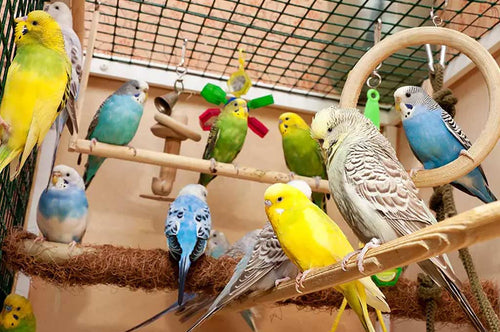
Happy budgies in a well-equipped birdhouse.

Cage Design
There are many types of cage available, but not all of them are designed with the needs of the bird and the owner in mind. A cage needs to combine sufficient space for the budgies with easy access for your hand, to replenish food and water every day and regular cleaning the contents. Budgies need space to fly, and also require perches. A smaller cage might not give the bird room to exercise its wings properly, and with badly designed cages it’s often tricky getting food and water bowls in and out.
- Budgerigar Cage Size
The minimum dimensions for a cage that will house single bird are 50x50x50cm (18.5 inches). Bigger is better, as budgies need space for horizontal flight. The bars should be closely spaced (not much more than 1cm apart) to prevent the bird from sticking its head out and possibly strangling itself, but perfect for gripping and climbing. - Budgerigar Cage Requirements
There should be nothing sharp in the cage, so check for any stray wires or ends of bars sticking out. This applies equally to the exterior, as your budgie, once finger-trained and able to leave the cage, will be exploring this area too. Any perch or toy you introduce should be without sharp edges or spikes, and should not have gaps into which a head or foot could be inserted but not easily retracted. It is also important to make sure the cage, and its contents, are not coated with a toxic paint or varnish. Anything showing signs of rust should be rejected too. - Budgerigar Cage Setup
A budgie will need several things in his cage: perches, feeding and drinking bowls, something to chew, a swing, some toys, a bird bath, and something to line the base of the cage. There’s lots more information on each of these budgie mod cons below. Always remember that the cage isn’t just a convenience, it’s a fully equipped residence for a bird you are bringing home as a member of the family. Give your budgie the best! - Budgerigar Cage Stands
Budgie cages can be placed on any secure furniture, or you can buy a purpose-made stand. These can be elevated platforms, or stands that incorporate a hook for hanging the cage. You need to be practical – the cage must be secure, so never position the stand where it might be knocked (children, dogs and vacuum cleaners are all guilty here). It also needs to sit comfortably in its surroundings, so don’t go for the luminous white uPVC option if the rest of your furniture is antique wood. - Budgie Cage Cover
Deciding to cover your budgie’s cage at night depends on where you live, and what the bird is used to. If your house or flat is in a busy area with lights being switched on and off all night or passing cars shining headlights through the gaps in the curtains, a cover will help the bird settle and get the regular sleep it needs – between 10 and 12 hours a night. The cover will also prevent your budgie from singing joyfully at dawn in the summer months, when, from a human perspective, sunrise doesn’t necessarily mean it’s time to get out of bed! You’ll need to remove the cover at a regular time each morning.
The important thing is to be consistent. If you’ve been covering the bird cage – or if the budgie was used to being covered before you bought it – carry on doing so. - Budgie Breeding Cage
If you keep lots of budgies, they will be in a large aviary rather than a cage. However, for breeding purposes budgie keepers sometimes isolate pairs in breeding cages with attached nesting areas. These are often multi-storey affairs, with separate compartments for each pair.
Geo Cage
Omlet’s Geo Bird Cage is the next generation luxury home for budgies. It takes on board all the requirements of a healthy and stimulating environment for your birds and combines revolutionary design with a truly stylish look. Dimensions of 62cm (H) x 60cm (W) x 60cm (D), with an integrated ‘no spill’ feeder and drinker, and catch waste for easy disposal. Cleaning is as simple as can be – an important consideration for many pet owners. The disposable paper liners collect all the mess and can be changed in seconds.
The Geo Cage has two doors, unlike most budgie cages, giving you easy access for feeding the birds and for adding cage trimmings such as swings and toys.
The Geo Bird Cage includes the feeder and drinker, paper liners, two perches, and has an optional choice of low and high stands, baths, mirrors, and night covers.
This is the premier of bird cages and worth saving up for. It’s the best present you’ll ever give your pet budgies!
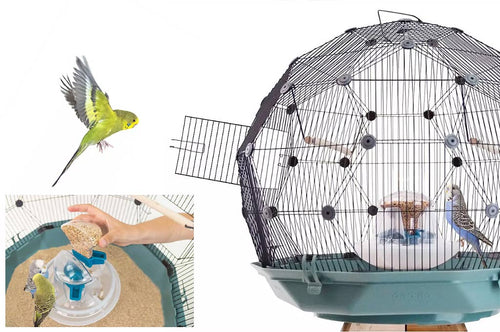 Shop Geo Cage
Shop Geo Cage Where to Position a Budgie Cage
Where you put the cage is just as important as what’s inside it. Somewhere in your home there’ll be an ideal place, but it might not be where you thought it was! Take on board these facts before bringing your pet home:
- The cage should be at chest or head height. Any lower and the bird will feel threatened by the hulking giant (i.e. you) looming over it. Put it too high or out of sight, and your budgie won’t feel part of the human environment. If you’re keeping an untamed budgie that no one can see properly, you should really ask yourself why you got the bird in the first place.
- Put the cage in a place that enables the bird to grow accustomed to constant human noise and activity, but not in the middle of a busy, high-decibel room where it might become a nervous wreck.
- Make sure one section of the cage is facing a wall. The budgie can then retreat into a quiet corner if something has startled him.
- Windowsills are not good places for budgies – they can overheat if the sun is shining through the glass, or catch a chill if there’s a draft.
- Following on from the last point, make sure the budgie’s cage is not in a drafty part of the house, including next to front or back doors.
- Don’t sit the cage over a radiator or near any kind of air-conditioning unit. The sudden changes in temperature will cause the budgie distress.
- Avoid keeping the cage in any room where aerosols are sprayed (bathrooms and bedrooms, for example). These release toxic chemicals into the air that can kill budgies.
- Don’t put the budgie in the kitchen. Steam can cause them distress, and the fumes from burnt food or cookware such as Teflon can be fatal.
- Once your budgie is free-flying, you’ll need to make sure windows are covered (the bird will not see the glass and is at risk of breaking his neck when he sets off to explore the great outdoors).
- Budgie-proof your room generally: switch off any fans or other dangerous appliances, remove fragile objects that the bird might knock down during his exercise, and use a fireguard if you have an open fireplace – even without the blatant hazard of a fire, the budgie can come to grief if he decides to explore up the chimney.
- Remove other pets from the room while the free-flight is taking place, unless you are confident they will not try to harm the bird.
- Does anyone smoke in the house? If they do, either get them to smoke outside, or take the budgie cage back to the shop and don’t buy a bird. It’s not a health warning you see on most packets, but cigarette fumes can kill budgies.
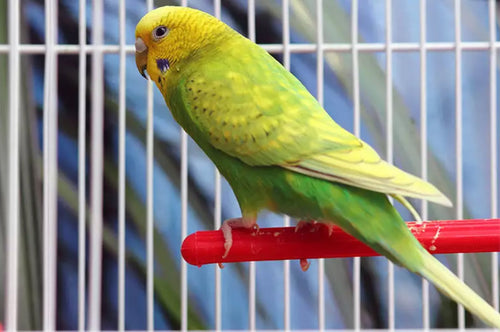
Cleaning a Budgie Cage
Budgie cages need cleaning at least once a week. The bottom tray and all plastic toys and bowls should be scrubbed clean and washed in hot, soapy water. The bars will need washing too. Make sure everything is completely rinsed and dried before returning the budgie to his home. Any wooden cage accessories, including perches, can be wiped with a damp cloth. You can buy bird-safe disinfectants from pet suppliers, if disease is an issue and you want to completely zap all known bacteria. This is not necessary for the weekly cleaning routine, however. A mixture of one part white vinegar to two parts water is a cheaper and greener solution. Cleaning the bars of the cage is an important part of the job, to prevent the build-up of potentially harmful bacteria. This is straightforward if you’ve moved the budgie elsewhere while you clean, but may cause a bit of panic if the occupant is still in the cage when you move in with the cloth or sponge. In a larger cage, the birds will have somewhere to retreat; and over time they will get used to the regular intrusion.
What To Do With a Budgie When Cleaning the Cage
If your budgie is hand trained, he can fly free while you clean his cage, or be transplanted to a spare cage. Younger, untamed birds are far more difficult to relocate. Catching them by hand or net causes stress that could put your training and acclimatising efforts back several weeks; and given that cleaning is a weekly requirement, you’ve got a problem on your hands.
Rather than catching the bird and moving it to a box or second cage, in the early days it is best if you can keep your budgie inside the top section of the cage. A simple way of doing this is to move the cage to the floor and unclip the tray section at the base. Your budgie will seek out his favourite safe place on a perch. Gently lift the top section off and place it back on the floor while you deal with the tray and the barred floor section of the cage. When the tray is dry and relined with wood shavings or newspaper, put it on the floor and lift the top section back on.
Toys and other removable parts can be cleaned and replaced. It may be easier to take a cloth to the inside of the cage to deal with dirty perches, mirrors, etc, in these early days. Yes, the bird will flap and panic a bit, but it will be less stressful for him than being captured and moved elsewhere.
Cage Cleaning Tips
In addition to the cleaning steps given above, the weekly hygiene routine is also a good opportunity to check whether any of the toys or perches are in need of replacement, and that the cage is in good order, with no rust or stray wires sticking out. You can also do a quick health check:
- Are the bird droppings the usual firm consistency and healthy colour (ranging from black and white to dark browns and dark greens, depending on your bird’s standard diet)?
- Is there a larger than usual amount of regurgitated seed in the cage?
- Has the budgie eaten as much food as usual?
A budgie will be perfectly happy on a cage floor of bars. Most of the mess the bird makes will then fall straight to the tray at the bottom of the cage for easy cleaning. You can put a thin layer of budgie sand in the tray, or some coarse sawdust or wood shavings (just make sure the latter come from untreated wood so that there are no issues with fumes, or with nibbling, if the budgie manages to get his beak on some of the shavings).

It is best to avoid a smooth, rounded perch.
It’s best not to have loose sand for the budgie to walk in. He will tend to eat a few grains, and this habit has been implicated in the premature deaths of some birds from a blocked crop (the muscular pouch in the bird's throat, where it can temporarily store swallowed food), or tumours.
Budgie Sand Perch
Sandpaper perches or sandpaper perch covers are often part of a standard cage kit. But, as noted in the Budgie Perches (next) section of this guide, they’re not needed.
Budgie Sandpaper and Budgie Sand Sheets
In addition to perch sandpaper, you can also buy sandpaper sheets for the base of budgie cages. No pet shop that stocks sand sheets will try to dissuade you from buying them, as they’ve been successfully selling them for the last 100 years. However, bear the following in mind:
- Plain paper or thick, plain, unprinted kitchen towel are popular sand alternatives.
- If there are natural wood perches in the cage, your bird has plenty of rough texture for his feet already; and, the toenail-manicure service the sand is said to provide is a myth.
- The standard, rectangular dimensions of sand sheets makes them tricky to install (and remove) in non-standard cages.
- Budgies sometimes eat the sand, which can cause digestive problems.
- If your budgie spends a lot of time walking on the floor of his cage, sandpaper may irritate his feet.

